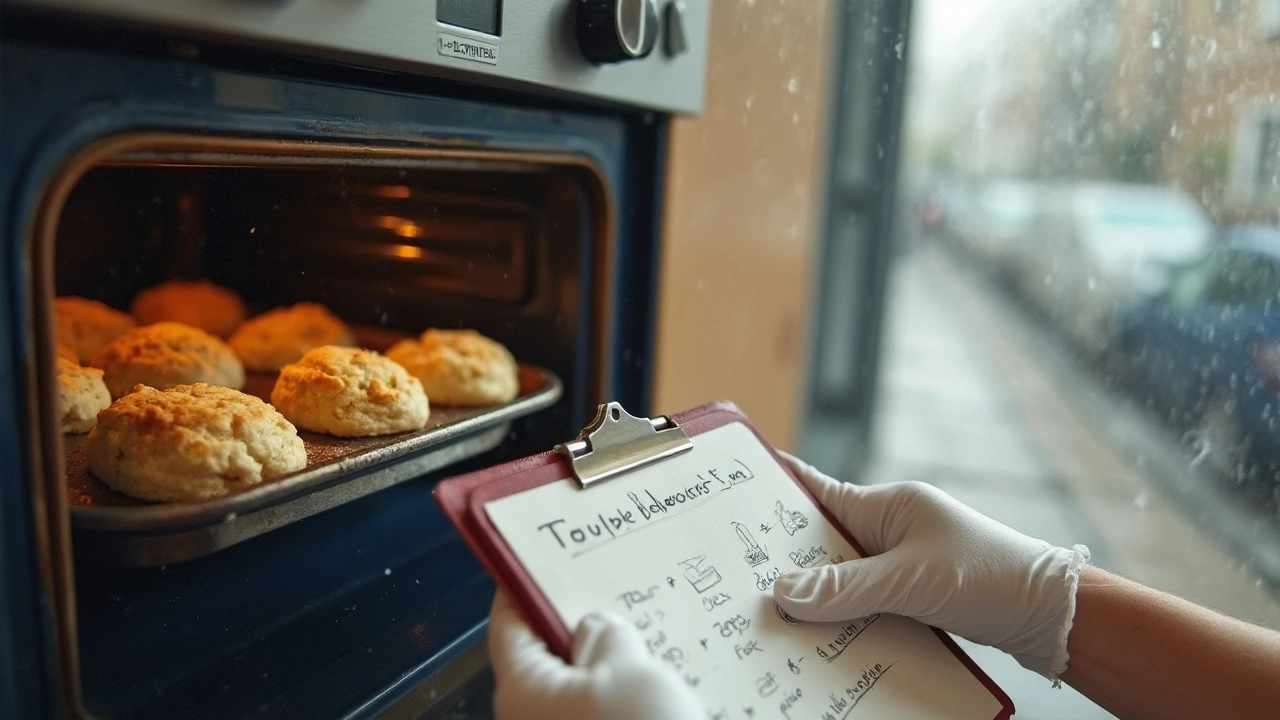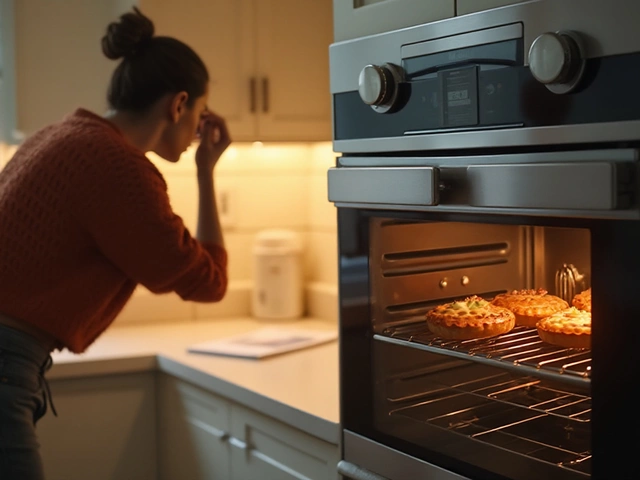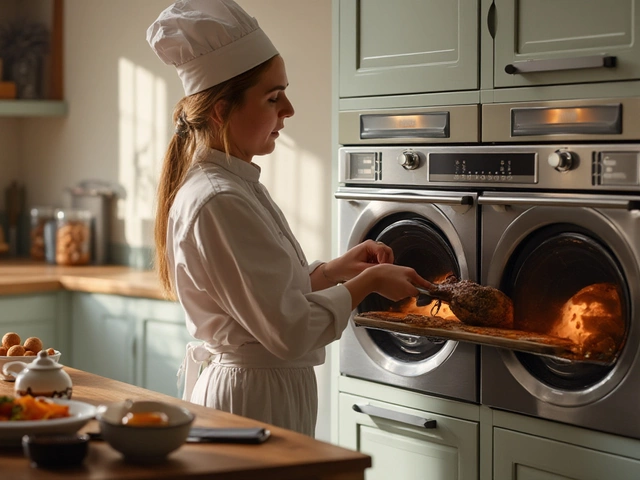Your dinner is waiting, the timer’s ticking, but the chicken is still pale. Sound familiar? Electric ovens can act up in sneaky ways—you don’t need a toolbox to spot most issues, just a bit of curiosity.
The first thing people usually notice is uneven cooking. If one side of your casserole is burnt but the other’s soupy, it’s probably not your grandma’s recipe at fault. Electric ovens often show trouble with temperature swings, weird noises, or lights that quit out of nowhere. Sometimes, the oven doesn’t turn on at all. Other times, the heating element glows but the food stays cold.
Start with the basics. First, double-check that you haven’t set the wrong cooking mode—we’ve all been there in a rush. Then, take a look for blinking error codes on newer models. Those codes are like the oven’s way of sending you a text about what’s wrong.
If you’re hearing loud clicks, buzzing, or humming, that’s your oven waving a red flag. Ignoring weird noises can cost you later. And if your kitchen smells like burning plastic or electrical, don’t play the hero—turn the oven off and unplug it.
- What’s Acting Up? Classic Symptoms
- Quick Checks Even Beginners Can Do
- When to Worry (And Call for Help)
- Handy Tips to Prevent Oven Problems
What’s Acting Up? Classic Symptoms
Lucky for us, a electric oven problem rarely hides. If your food takes forever to cook or ends up half-cold and half-burnt, don’t blame your recipe just yet. Uneven heating is one of the tell-tale signs something’s not right. Usually, a busted heating element is to blame, but sometimes it’s a tired thermostat that messes up the temp.
Here’s a checklist of classic oven trouble signs to watch for:
- Oven won’t turn on at all: Before you panic, check the power supply and plug. But if it’s dead silent and cold, it’s probably a bigger issue like a blown fuse, faulty wiring, or a died-out control board.
- Food cooking unevenly: If that frozen pizza is burnt on one side and raw on the other, the oven might have a dodgy heating element or a bad sensor.
- Strange noises: Clicking, buzzing, or humming? Ovens should be quiet, so any new sounds are worth a listen. It could be a faulty relay or fan kicking up trouble.
- Oven light won’t work: Sometimes it’s just the bulb, but if you’ve changed it and nothing happens, the light switch, wiring, or control board may be shot.
- Oven won’t heat: A glowing element isn’t a guarantee that it’s working right. Some die partially, giving just enough heat to tease but not actually get the job done. Bad temperature sensors are another sneaky culprit.
- Display shows error codes: Modern ovens love to tell you when something’s wrong. Error codes can point straight to the problem if you check the manual or manufacturer’s site.
Most issues you’ll spot come from three main parts: heating elements, sensors, or electrical problems (like bad wiring or a control board failure). Quick fact: According to a 2023 appliance repair survey, over 60% of electric oven failures were linked to either faulty heating elements or sensors. So, start your detective work there if you’re seeing the classic issues.
Quick Checks Even Beginners Can Do
You don’t need to call a pro for every electric oven problem. Most issues start with something simple, and a lot of folks fix it themselves in minutes. Here’s where to start before you even think about calling in a repair service.
- Power supply: Check if the oven is plugged in all the way. This sounds basic, but sometimes cords get jostled. If your oven has a digital clock or controls and they’re blank, a tripped circuit breaker could be the culprit. Head to your circuit box and make sure nothing has flipped off—this is way more common than you think.
- Heating element: Open the oven and look at the top and bottom heating elements. When you turn the oven on, both should glow orange-red. If one stays dark or looks broken, it’s probably burned out. Swapping out a heating element is usually as easy as unplugging it and popping a new one in.
- Oven door seal: Run your hand around the oven door when it’s closed (careful, it might be warm). If you feel hot air blowing out or see gaps in the rubber gasket, you’re losing heat and getting uneven cooking. Replacement seals are cheap and easy to install.
- Error codes: Modern ovens flash codes like “F3” or “E2” on their display when something’s wrong. Grab your oven’s manual (or google the model) and look up what the code means. Sometimes it’s just a sensor loose or a simple reset.
- Temperature check: If you think your oven isn’t heating up right, place an inexpensive oven thermometer on the middle rack. Set the oven to 350°F (about 177°C), wait 20 minutes, and check the reading. If there’s more than a 30-degree difference, your oven might need recalibrating or a new thermostat.
| Quick Check | How Often It’s the Cause |
|---|---|
| Tripped Circuit Breaker | About 20% |
| Burned-Out Element | Roughly 35% |
| Bad Door Seal | Nearly 10% |
| Error Code Issue | Close to 15% |
| Bad Thermostat | Roughly 20% |
A lot of oven repair starts with these moves. Skip the stress, check these things yourself first, and you might just be able to save your dinner and your wallet.

When to Worry (And Call for Help)
There’s a big difference between a quick DIY fix and a electric oven problem that could turn dangerous. Some signs are dead giveaways that you should call a pro—don’t mess around if you spot these.
- Strange Burning Smells: If your electric oven smells like burning wires or plastic, shut it off and unplug it right away. That’s often a sign of electrical trouble or a melting wire jacket, which can cause serious damage or even start a fire.
- Power Flickering or No Power: If your oven keeps turning itself off, or there’s absolutely no response when you try to use it, this can mean a busted control board, blown fuse, or broken wiring. Those issues need a tech with the right tools—don’t go poking around inside.
- Heating Elements Not Glowing or Cracked: A cold heating element when it should be hot, or one that shows cracks, sparks, or scorch marks? Time to bring in a pro. Heating elements can short or shock you if handled wrong.
- Control Panel Error Codes: Modern ovens often flash codes when trouble pops up. Some codes mean you can reset with a button, but others point to deep problems with the circuit board or internal wiring. If searching your model’s code online points to a service fix, don’t wait.
- Unusual Noises: A low hum is normal, but grinding, popping, or loud buzzing can mean a fan’s about to die or wires are arcing. These can shut your oven down for good if you ignore them.
If in doubt, always play it safe. According to the U.S. Fire Administration, cooking appliances cause over 50% of home fires each year—and many start with an unnoticed oven repair issue. Never try to fix wiring or swap out complicated parts on your own unless you’re trained for it.
| Red Flag | Why It’s Serious |
|---|---|
| Burning Smell | Potential electrical fire hazard |
| No Power | Could signal faulty wiring or control board |
| Sparking Element | Electrical short, shock risk |
| Error Codes | Possible circuit or sensor issue |
| Weird Noises | Mechanical or electrical failure |
If you’re ever unsure, skip the guesswork and reach out to an appliance repair tech. It’s way safer (and usually quicker) than hoping the problem just sorts itself out.
Handy Tips to Prevent Oven Problems
If you’re tired of surprise breakdowns and last-minute pizza nights, it's time to get a little proactive with your electric oven problem prevention. Keeping things simple is the way to go—regular attention beats expensive repairs every time.
- Don’t let grime build up: Wipe up spills as soon as the oven cools down. Baked-on food can mess with the heating elements, and a dirty oven works harder than a clean one, using more electricity.
- Check the door seal: If heat escapes, your oven has to work way harder. Run your finger around the rubber gasket. If it’s cracked, squished, or loose, it’s time to replace it—most seals just pop right out and in.
- Mind your racks: Bent racks can throw off cooking and block the door from shutting right. Slide them in and out every now and then—if they stick, clean and dry them so they don’t rust or warp.
- Be gentle with the controls: Over-twisting dials or pounding buttons can wear out electrical switches and display panels. Callista once almost broke ours with an excited fist bump. Keep the controls simple and calm.
- Test the temperature: Oven thermostats can drift over time. At least twice a year, stick an oven thermometer inside, set to 350°F, and see if it actually hits the mark. If it’s off by more than 20°F, it’s time to get the thermostat checked or recalibrated.
If you want to get technical (or just love data), here’s a quick look at what can cause the most common oven repair issues—sometimes prevention really is about knowing what messes up most often:
| Oven Problem | % of Cases from Service Calls |
|---|---|
| Heating Element Failure | 34% |
| Faulty Door Seal | 26% |
| Control Panel or Switch Malfunction | 19% |
| Thermostat Issues | 15% |
| Other | 6% |
One last thing—unplug your oven before cleaning deep inside or poking around with a tool. Even a powered-off oven can zap you because of hidden energy stored in the circuits. Skip DIY electrical fixes unless you really know what you’re doing, or else you might turn a wiring goof into a fire hazard.




